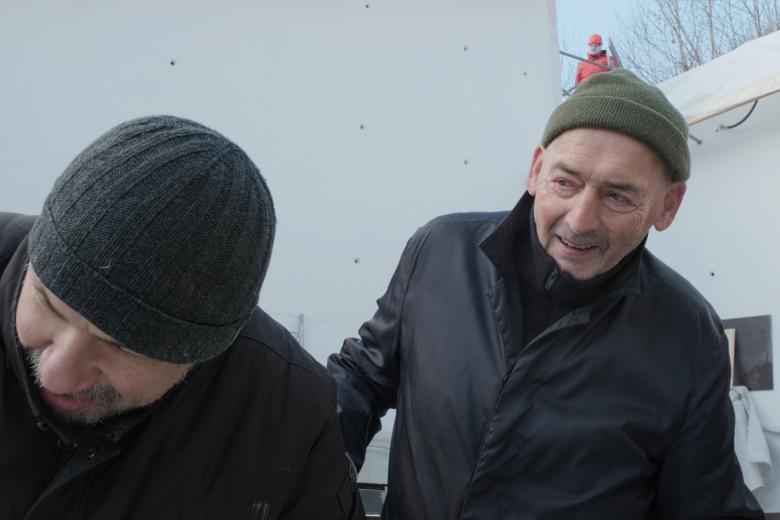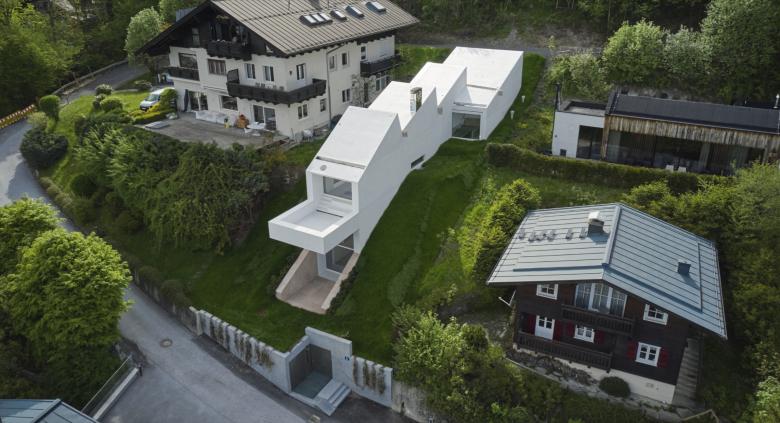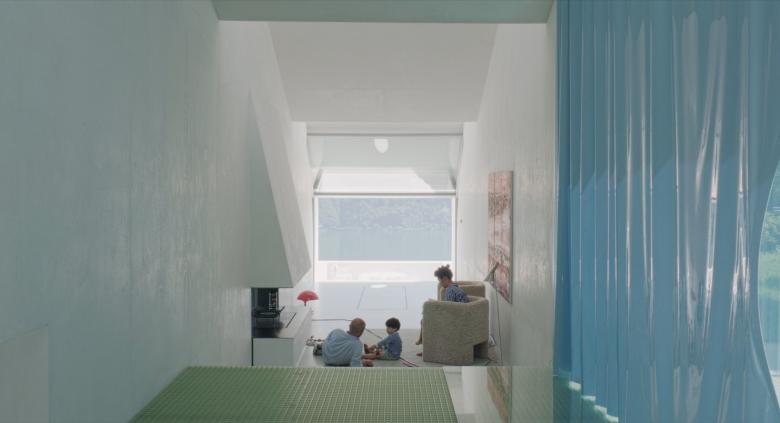17. January 2024
OMA's Rem Koolhaas, at right, and Federico Pompignoli admiring the view. (Photo: Screenshot)
Point of Origin – Building a House in Austria documents the construction of an alpine house designed by Rem Koolhaas that is notably the Dutch architect’s first house realized since the House in Bordeaux 25 years ago. With apparently unfettered access to architect, client, and construction site, photographer Frans Parthesius’s film reveals the house as it takes shape on a hillside of Lake Zee.
At nearly halfway through Point of Origin, as the concrete retaining walls and stairs are starting to give the house some definition, architect and client are admiring an unexpected view of the nearby lake. Christopher Schläffer, the tech entrepreneur who commissioned Koolhaas, says it is “fantastic.” His wife, Anh Nguyen, exclaims it is “spectacular.” Koolhaas calls it “unbelievable.” As the three of them, joined by OMA architect Federico Pompignoli, admire the view with wide grins on their faces, one of them — it’s not quite clear who says the words, though the captions spell them out — goes even further, saying “this is the soul” of the house. But Parthesius keeps his camera close on their faces for the nearly three-minute sequence, never showing us the view, never letting us see what they see, even when architect and client pose for photos in front of the lake vista. Viewers will not grasp the view for another twenty minutes, until the last minutes of the film, when construction is complete and the client has moved in. As such, Point of Origin is a slow, 46-minute reveal of Koolhaas’s latest — his last? — residential masterstroke: a filmed scenario of architectural tension and release, of delayed gratification.
Although Parthesius limits the film’s footage to the construction site in Zell am See and the occasional conference room, the presence of Koolhaas’s previous houses in the Netherlands and France is undeniable. Schläffer admits at the beginning of the film, in a voiceover accompanying a time-lapse panorama of the lake over the course of the house’s construction, that he is “utterly privileged, knowing that Rem's history of small houses is rather limited." Small is a relative term: Villa dall'Ava (1991) is 1,350 m2; Dutch House (1997) is 517m2; Maison à Bordeaux (1998) is 500m2. These houses are larger than the average home, even by American standards, but they are small compared to an unbuilt house Koolhaas designed at some point in the intervening 25 years for a site on the French Riviera, a 2,500-m2 project the architect describes in the film as more “palace” than “house.” At 280 m2, the Austrian house snugly fits within the “house” bill, allowing the nearly 80-year-old Koolhaas to be involved in every detail of its design and realization. With OMA’s larger projects now handled by Koolhaas’s younger colleagues, this house can safely be called a Koolhaas project, a label others often ascribe to buildings designed by Reinier de Graaf, Ellen van Loon, Shohei Shigematsu, and other OMA partners.
Aerial view of the 4-meter-wide house in the landscape. (Photo: Screenshot)
Point of Origin comprises roughly ten “scenes,” including the panoramic time-lapse and revelatory site visit mentioned above. Other scenes move between edited security camera footage with voiceovers, interior shots of the house’s nearly two-year construction, and site visits with OMA’s Pompignoli, local architect Carl Schläffer, and others, including Petra Blaisse, who furnishes the house with a number of bespoke curtains. It’s hard to consider the house in Austria without the contribution of Blaisse, Koolhaas’s life partner and founder of Inside Outside. Similar to her work on OMA’s Kunsthal (1999), Casa da Musica (2004), and Seattle Public Library (2005), Blaisse’s curtains add color and texture to the whitewashed modernism of the house’s interiors and accentuate certain views of the landscape — those “fantastic,” “spectacular,” “unbelievable” views.
Parthesius’s decision to slowly unveil the design of the house over the course of the film, to hold back certain views and design features until the last minutes, makes sense in the context of the film's world premiere at AFFR last October, which took place a couple of weeks before the house was unveiled in the pages of Architectural Digest, but over time, as the house receives wider dissemination, the tactic won't have the same impact on knowledgable viewers. Regardless, the film's fly-on-the-wall approach commendably recalls the documentaries of Frederick Wiseman, who trained his camera on people in apparently mundane situations — so many meetings! — in such films as Aspen (1991), National Gallery (2014), and Ex Libris (2017), revealing how governments and institutions work and how people interact. His films are long (Ex Libris is 197 minutes) and laborious at times, but they are also rewarding and very telling of our shared humanity. It would be a stretch to say that Parthesius has pulled off a similar feat with Point of Origin, but the site visits and off-site meetings do nevertheless reveal a little bit about the architectural process and the relationship between architect and client. The voiceovers and static security camera footage, though, are the most enthralling parts of the short doc: The words and images mesh in these scenes to tell the story of the house in a way that is more interesting than if Christopher Schläffer or Rem Koolhaas were saying the same words directly to the camera.
Christopher Schläffer, Anh Nguyen, and their son in the completed house. (Photo: Screenshot)
That’s nice, you might be thinking, but how about the design of the house? Outside of it being a Rem Koolhaas creation, what makes it so special it has its own film? One way to describe the house is as a balance of opposites: the desire to capture distant views while keeping the house low due to height restrictions; the need for a decent-sized “small” house and the reality of a narrow, 12-meter-wide lot and setbacks restricting the house's volume to no more than four meters wide above grade. The house looks compact from above, gently following the slope of the land, but, like the House in Bordeaux, there is a lot going on beneath the surface, literally and figuratively. Basement levels, for instance, allow for spaces wider than in the serrated volume above, while hatches, garage doors, Blaisse's curtains, and other moving pieces give the house some flexibility and elements of surprise. A minimal balcony projects from the front of a house like a tongue, reaching out as much as is physically possible toward the lake and the mountains — the view so prized by everyone involved.
Director: Frans Parthesius
Production: Netherlands, Austria, 2023
Running Time: 46 minutes
Languages: English and German, with English subtitles
World Premiere: AFFR, Rotterdam, October 2023


